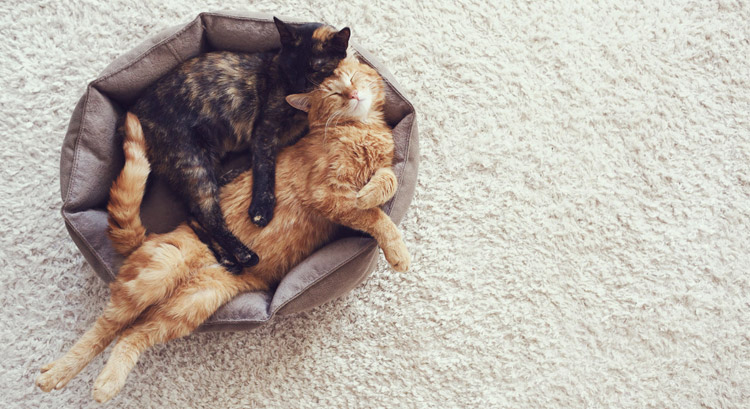Welcoming a pet into your home is an exciting new adventure, and preparing your home thoroughly will help to ensure that all creatures great and small can stay safe. Flooring provider, Posh Flooring, collaborated with a range of pet-loving pros to get the expert scoop on pet safety in the home. From keeping anything harmful out of paw’s reach to creating a pet-friendly space, here’s everything you need to know to get your home ready for your furry new arrival.

Give Them Their Own Space
Just like humans, pets love having a little space of their own, so make sure they have a comfortable living environment, including a well-padded bed, a bowl of fresh water, and some room to move around in.
Mai and Janine, from Not Just Pets, recommend that you, “think about where they will eat their meals, where you will store their toys and food, and where they will play and sleep”.
Dr Jessica Vogelsang, from Pawcurious, points out that animals are creatures of habit, so will come to recognise designated spaces as one to come back to, either for toys and treats or as a place to rest. Kimberley, from Keep the Tail Wagging, found using baby gates was helpful when training her pets:
“There is one gate to keep the dogs from going upstairs (the cats’ domain) and sometimes we’ll block off one room while cleaning, instead of putting the dogs outside. Before we brought our puppies home we had everything set up for them: crate, playpen, toys, and food and water dishes.”
For rabbits in particular, Tamsin, from The Rabbit House, suggests that enclosed areas are perfect as a starting point to help them become accustomed to their new home. After a few calm days, you can expose them to bigger spaces, letting them explore further and feel comfortable with their new environment.

Check Your House From Top To Bottom
We all know that pets like to roam around, so your entire house has to be prepped and ready. Exactly what needs doing will largely depend on which type of animal you are getting; so Mai and Janine advise making this decision as early as possible, so that you can get the house ready in advance.
It’s very important to consider the environment your pet will occupy – birds that can be let out of a cage may well end up in more unusual spots than the average dog will! These spaces will need to be cleared of anything potentially dangerous, so Kimberley recommends keeping floors, tables, and worktops clear, preventing animals from chewing on something they shouldn’t – or even choking.

An excellent way of detecting any possible risks is to get down to the animal’s level – lower yourself onto the floor and take a look at what is visible closer to the ground. Wires and electrical equipment could be hazardous for smaller pets, such as rabbits, and certain houseplants can be toxic to animals.
Look out for household chemicals or medications – according to Dr Jessica, these can cause significant harm but are often overlooked. Keep them locked securely in high-up cabinets where pets won’t find them.
Seal or cover up any nooks and crannies that small pets could get stuck in – gaps in kitchen units are a classic trap. Be sure to shut any doors and windows they could squeeze through, too.
Make Sure The Floor Is Suitable For Paws
Whether you’re preventing any slips and slides, or preparing to clean up after any little accidents, different floors will serve different purposes. According to Kimberley, “hardwood or tiled flooring is ideal for a pet-friendly home. Some dogs struggle with the slippery feel of non-carpeted flooring, so we put down rugs here and there to help our dogs get used to the floor. When there is a mess, it’s quick and easy to clean up.”

However, if your pets are a little bit older, hard floors could prove problematic, says Jessica: “For older pets, hardwood floors can make getting up and down challenging, especially if they have arthritis. I use a lot of throw rugs in our home, because once they’re trashed I can just throw them away instead of having to replace the flooring!” Unlike cats and dogs, rabbits have fur on their feed instead of a pad, which makes it harder for them to keep their balance on hard floors. According to Tasmin, “If you don’t want to change the whole floor, then a rug or rubber matting will let your bunny hop around safely without sliding”.
If you need a flooring option for your rabbit’s space or lining for a hutch, safety flooring will provide good grip, as well as being easy to clean.
Training
This can be tricky, but the important thing is to keep working at it. Jessica notes that, “It doesn’t matter how experienced a pet owner you are, going to a basic training class is an excellent way to reinforce your relationship, bond with your pet, and practise basic social skills”.

Rewarding good behaviour is a simple option for cats and dogs, but regardless of the type of pet you own, be prepared to clean up a couple of accidents while they are adjusting. If you think you need any help, a professional trainer can give you a range of advice and tips.










